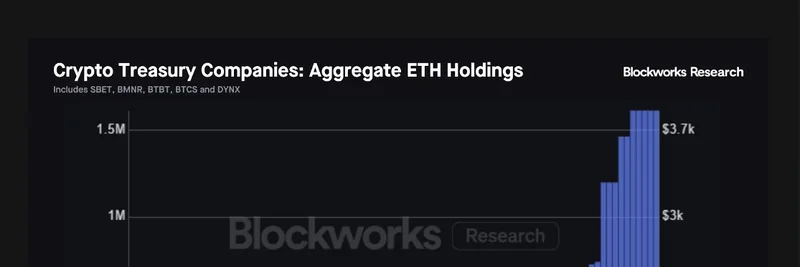In the ever-evolving world of cryptocurrency, a new trend is catching the eye of investors and blockchain enthusiasts alike. Digital Asset Treasuries (DATs), essentially companies that hold significant amounts of crypto like Ethereum (ETH) on their balance sheets, are making waves. According to a recent post on X by Marc Arjoon, a researcher at Blockworks, these DATs are altering the demand dynamics for ETH and currently hold about 2% of the total supply. That's no small feat in a market as vast as Ethereum's.
Marc highlights that liquidity is paramount, especially for funding through at-the-market (ATM) equity sales. If you're new to this, ATM offerings allow companies to sell shares directly into the market over time, providing flexible capital raising without the drama of a big public offering. But as volumes dip, it gets trickier. He shared some eye-opening snippets from the July Ethereum monthly update to back this up.
Let's dive into the details. One key insight is the massive inflow into these treasuries. In July alone, five selected DATs added nearly 1.4 million ETH—worth about $5.5 billion—to their holdings. That's more than what even the popular ETH ETFs managed to pull in. The chart below shows how these aggregate holdings have skyrocketed over the past four months.
This accumulation isn't just a blip; it's part of a broader trend where public companies are betting big on ETH. Collectively, DATs now control over 1.3% of the total ETH supply, with the sharpest growth kicking in from mid-July. This signals growing institutional confidence in Ethereum as a strategic asset. Here's the visual on the share of ETH held by these entities.
But it's not all smooth sailing. Companies like SBET and BMNR are heavily reliant on ATM sales to fund their ETH buys, and declining trading volumes are putting a squeeze on that strategy. Without strong daily liquidity, issuing shares becomes riskier, potentially leading to stock price drops or excessive dilution for shareholders. As volumes trend lower, these firms might need to pivot—maybe slowing down purchases or exploring other financing options to avoid weakening their market position. Check out the trading volume chart for a clearer picture.
Why This Matters for the Crypto Ecosystem
For blockchain practitioners and meme token enthusiasts, understanding these dynamics is crucial. DATs aren't just hoarding ETH; they're influencing supply and demand in ways that could ripple through to smaller projects and tokens built on Ethereum. With ETH being the backbone of many DeFi protocols and NFT marketplaces—where meme tokens often thrive—a tighter supply could mean higher prices and more volatility.
Think about it: if institutions are locking up ETH in treasuries, it reduces the circulating supply, potentially driving up value. But liquidity issues could force sales, creating downward pressure. It's a delicate balance, and keeping tabs on your favorite DAT's volume, as Marc suggests, is smart advice.
Community Reactions
The post sparked some interesting replies. One user pointed out that 2% of ETH in DATs is like a "whale in a kiddie pool," emphasizing the concentration of power. Others echoed the importance of volume, noting that ATM yields only work if there's market participation. There's also concern about what happens if that illiquid 2% needs to be sold—could it crash the market?
As we at Meme Insider continue to track these developments, it's clear that DATs are becoming a force in the ETH landscape. Whether you're a degen trader or a long-term holder, staying informed on these institutional moves can give you an edge in navigating the crypto waters. For more insights, check out Blockworks Research or follow Marc on X.
If you're into meme tokens, remember that Ethereum's health directly impacts the playground where most memes launch. Rising institutional interest could mean more capital flowing into the ecosystem, potentially boosting innovative projects and communities.



